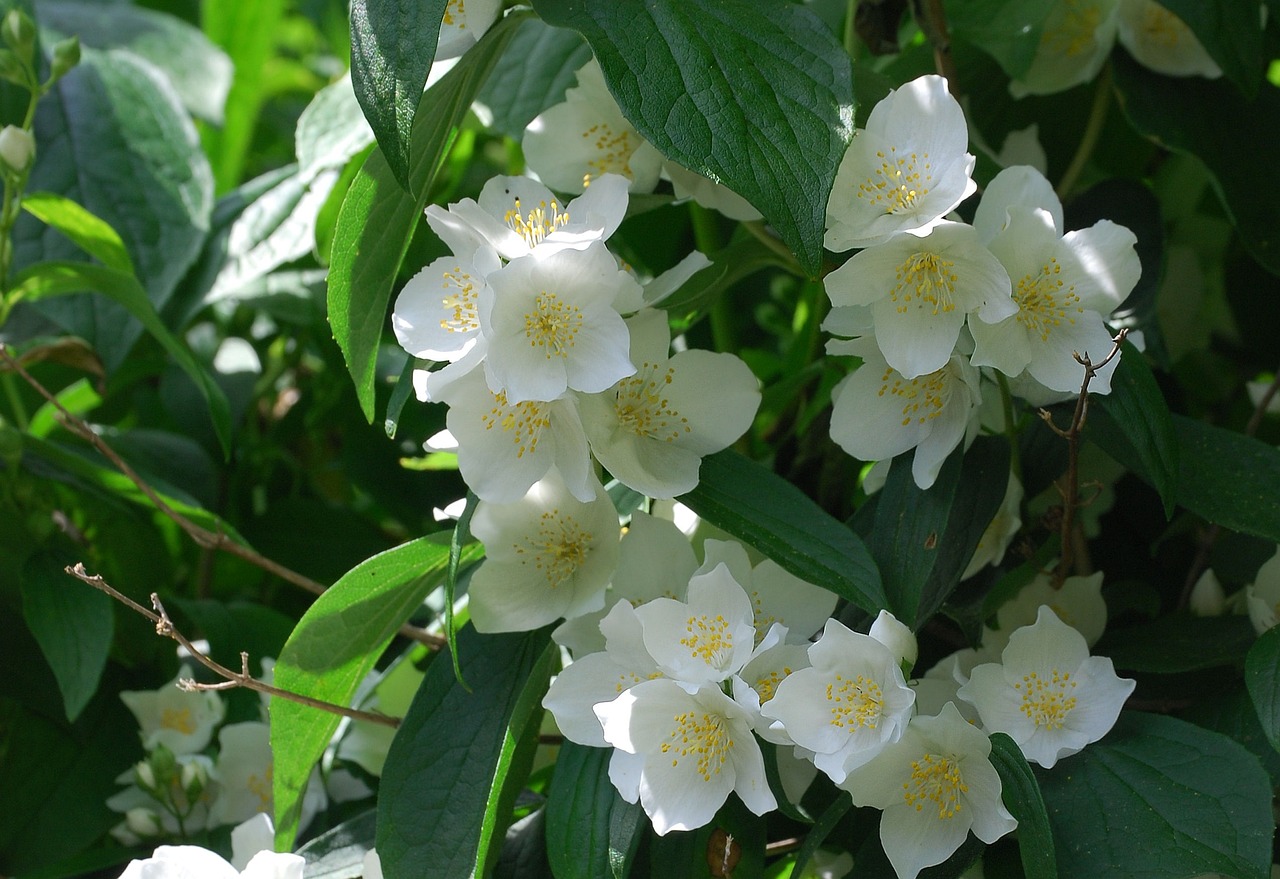Hi @diane-g
It's great to hear from you again about your Philadelphus shrub, known as Mock Orange, for its scent, which people love or hate!
The niggle with Philadelphus is they are a bit unruly when it comes to training and controlling. This is part of why I love them; they just tend to do their own thing. For now, I would nip out maybe 6 inches off the top leader stems back to a bud just to balance the shape while the rest catches up.

It may not behave as you expect it, and like I said, they can take over a bit; however, they respond really well to hard pruning, which I do with mine all the time when they get a bit wayward! See step 5 below for hard pruning guidance.
Let me explain for other Garden Ninjas how to prune any size of Philadelphus.
1. When to Prune Philadelphus
Philadelphus shrubs bloom on old wood, meaning their flowers grow on the previous year's growth. The best time to prune is immediately after flowering in late spring or early summer. Pruning at the right time ensures that you won't remove next year's flower buds.
2. Tools You'll Need
- Sharp pruning shears for thinner branches.
- Loppers for thicker, older wood.
- Disinfectant to clean your tools and prevent disease spread between cuts.
https://youtu.be/zsdpzrxxOj8
3. Why Prune Philadelphus?
Pruning Philadelphus keeps the shrub from becoming overgrown and tangled, while encouraging new growth, which results in more abundant flowers. It also improves airflow through the plant, reducing the risk of disease and promoting healthy growth.
4. Steps for Pruning Philadelphus
Follow the simple steps below as a step by step guide for pruning Mock orange.
a. Remove Dead, Damaged, or Diseased Wood
Start by inspecting the shrub for any dead, damaged, or diseased branches. These are usually discoloured, brittle, or showing signs of disease, such as black spots or fungal growth. Prune these branches back to healthy wood or down to the base of the plant.
b. Thin Out Older, Unproductive Stems
Philadelphus blooms best on younger wood. Every year, remove about a third of the oldest stems right down to the ground. This opens up the center of the shrub and encourages new shoots to grow from the base. These younger shoots will bear flowers in future years, keeping your plant vigorous and blooming.
c. Cut Back Flowered Stems
After your Philadelphus has finished blooming, cut back the flowering stems to a strong bud or side shoot. This helps the plant conserve energy while promoting fresh growth that will bear flowers next year. Be sure to avoid cutting back into the old wood that has not produced flowers, as this may reduce blooming the following year. It also stops the Mock orange from getting leggy and out of control!
d. Shape and Control the Size
Once you’ve removed the older stems and spent flowers, take a step back and assess the overall shape of your shrub. Trim any overly long or leggy branches to keep the shrub compact and balanced. This is especially important if your Philadelphus is growing too large for its space. They often spill out and outgrow a garden border when they get to 5 years old in my experience.
5. Pruning Overgrown Philadelphus
If your Philadelphus has become overgrown or neglected, it may benefit from rejuvenation pruning or hard pruning. This involves cutting the entire shrub back to about 30 cm (1 foot) from the ground in late winter or early spring before growth starts. The shrub will respond with vigorous new shoots, though it may take a year or two for flowering to resume fully.
6. Aftercare
Once pruned, water your Philadelphus well, especially during dry spells, to help it recover and encourage strong regrowth. Applying a layer of mulch around the base of the plant can help retain moisture and suppress weeds.
Hope that helps?
Lee Garden Ninja
Hi @diane-g
It's great to hear from you again about your Philadelphus shrub, known as Mock Orange, for its scent, which people love or hate!
The niggle with Philadelphus is they are a bit unruly when it comes to training and controlling. This is part of why I love them; they just tend to do their own thing. For now, I would nip out maybe 6 inches off the top leader stems back to a bud just to balance the shape while the rest catches up.

It may not behave as you expect it, and like I said, they can take over a bit; however, they respond really well to hard pruning, which I do with mine all the time when they get a bit wayward! See step 5 below for hard pruning guidance.
Let me explain for other Garden Ninjas how to prune any size of Philadelphus.
1. When to Prune Philadelphus
Philadelphus shrubs bloom on old wood, meaning their flowers grow on the previous year's growth. The best time to prune is immediately after flowering in late spring or early summer. Pruning at the right time ensures that you won't remove next year's flower buds.
2. Tools You'll Need
- Sharp pruning shears for thinner branches.
- Loppers for thicker, older wood.
- Disinfectant to clean your tools and prevent disease spread between cuts.
3. Why Prune Philadelphus?
Pruning Philadelphus keeps the shrub from becoming overgrown and tangled, while encouraging new growth, which results in more abundant flowers. It also improves airflow through the plant, reducing the risk of disease and promoting healthy growth.
4. Steps for Pruning Philadelphus
Follow the simple steps below as a step by step guide for pruning Mock orange.
a. Remove Dead, Damaged, or Diseased Wood
Start by inspecting the shrub for any dead, damaged, or diseased branches. These are usually discoloured, brittle, or showing signs of disease, such as black spots or fungal growth. Prune these branches back to healthy wood or down to the base of the plant.
b. Thin Out Older, Unproductive Stems
Philadelphus blooms best on younger wood. Every year, remove about a third of the oldest stems right down to the ground. This opens up the center of the shrub and encourages new shoots to grow from the base. These younger shoots will bear flowers in future years, keeping your plant vigorous and blooming.
c. Cut Back Flowered Stems
After your Philadelphus has finished blooming, cut back the flowering stems to a strong bud or side shoot. This helps the plant conserve energy while promoting fresh growth that will bear flowers next year. Be sure to avoid cutting back into the old wood that has not produced flowers, as this may reduce blooming the following year. It also stops the Mock orange from getting leggy and out of control!
d. Shape and Control the Size
Once you’ve removed the older stems and spent flowers, take a step back and assess the overall shape of your shrub. Trim any overly long or leggy branches to keep the shrub compact and balanced. This is especially important if your Philadelphus is growing too large for its space. They often spill out and outgrow a garden border when they get to 5 years old in my experience.
5. Pruning Overgrown Philadelphus
If your Philadelphus has become overgrown or neglected, it may benefit from rejuvenation pruning or hard pruning. This involves cutting the entire shrub back to about 30 cm (1 foot) from the ground in late winter or early spring before growth starts. The shrub will respond with vigorous new shoots, though it may take a year or two for flowering to resume fully.
6. Aftercare
Once pruned, water your Philadelphus well, especially during dry spells, to help it recover and encourage strong regrowth. Applying a layer of mulch around the base of the plant can help retain moisture and suppress weeds.
Hope that helps?
Lee Garden Ninja
 Lee Burkhill: Award Winning Designer & BBC 1's Garden Rescue Presenters Official Blog
Lee Burkhill: Award Winning Designer & BBC 1's Garden Rescue Presenters Official Blog



